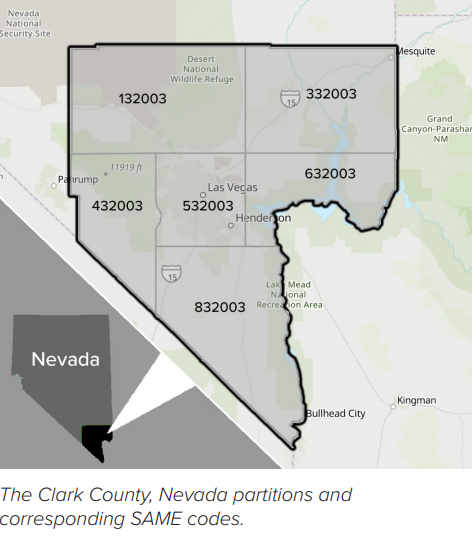SUMMARY
One way the National Weather Service (NWS) meets its missions to protect the public is to send weather warnings via NOAA Weather Radio (NWR). The Emergency Alert System (EAS), in turn, uses NWR to get out life-saving alerts. Broadcasters use EAS to interrupt programming for vital NWS warnings. Users with NWR receivers equipped with Specific Area Message Encoding can program their radios with a 6-digit county code to receive alerts for one or more counties. Click here for technical details.
Because NWR is county-based, if an NWS office forecasts that even a small part of a county is impacted by a storm, the entire county is alerted. This frequent alerting most strongly impacts large or uniquely-shaped (e.g., panhandle); or configured (e.g., islands) counties. The NWS has received complaints about receiving "too many EAS alerts" for a county and "too many warnings which are not applicable to my area of the county." Similarly, broadcasters have expressed concerns about sending EAS activations that do not apply to their broadcast service area.
NWS Las Vegas coordinated with Emergency Managers, the Nevada State Emergency Communications Committee, broadcasters, state and local government officials, EAS encoder/decoder manufacturers, and NWR receiver manufacturers to allow the office to use partitions for the following warnings:
Click here for the official news release!
What is Partial County Alerting (PCA)?
Partial County Alerting creates more geographically precise weather alerts, which means the alerts you receive are relevant to your area. In simple terms, it means fewer interruptions by TV and radio broadcasters to the shows you watch or listen to on stations which convey National Weather Service (NWS) warnings via the Emergency Alert System (EAS). It also means you will receive fewer warnings from most NOAA Weather Radio (NWR) receivers. Without PCA, the entire county is alerted by EAS and NWR, even if only a small part of the area is likely to be impacted by a weather warning.

What's changing?
We are dividing Clark County into six smaller alerting areas for SAME-enabled NOAA Weather Radios and devices using the Emergency Alert System (EAS).
For Clark County, our example, the text scroll of the warning will state the National Weather Service has issued a Flash Flood Warning for “Northeast Clark County, Northwest Clark County.” The cardinal language descriptions are fixed as follows:
| Location Code for EAS and NWR SAME | Enhanced Message the Public will See/Hear |
| 032003 | Clark County |
| 132003 | Northwest Clark County |
| 332003 | Northeast Clark County |
| 432003 | West Clark County |
| 532003 | Central Clark County |
| 632003 | East Clark County |
| 832003 | South Clark County |
Why do this?
Clark County is a BIG county and many times when weather threatens a small portion of the county, everyone in the county is alerted. These changes will provide more specific area alerting. Likewise, your local TV station or media provider can use the information to make more informed decisions on when to interrupt regular programming.
When is this happening?